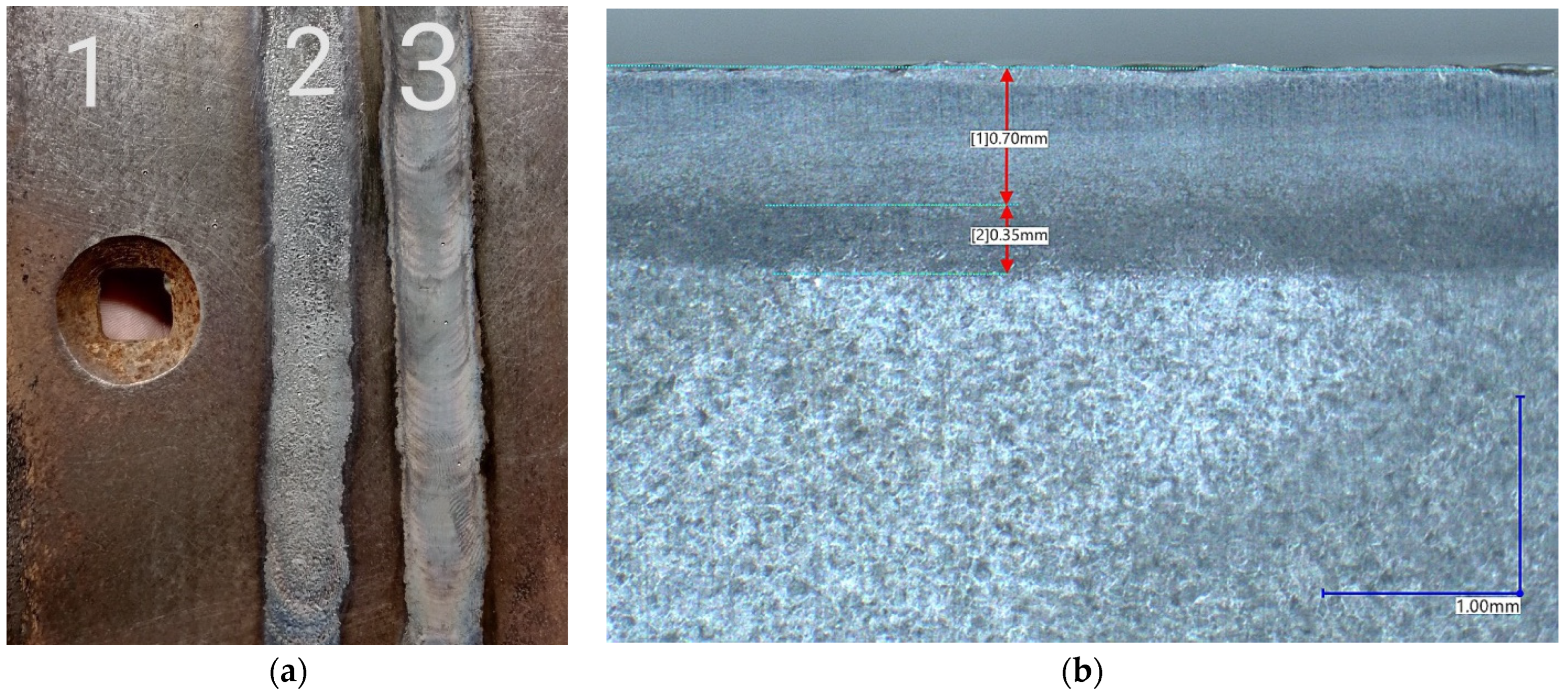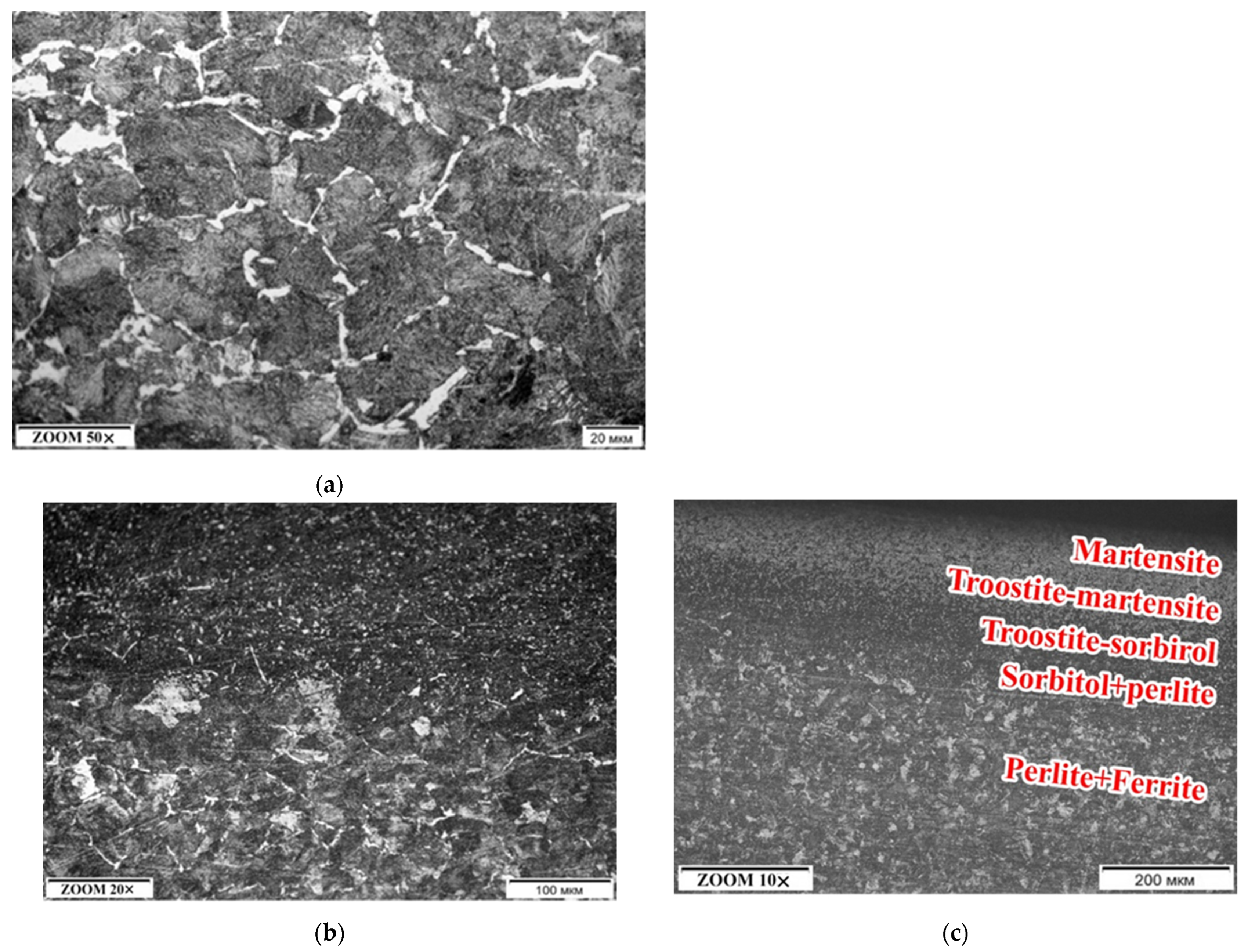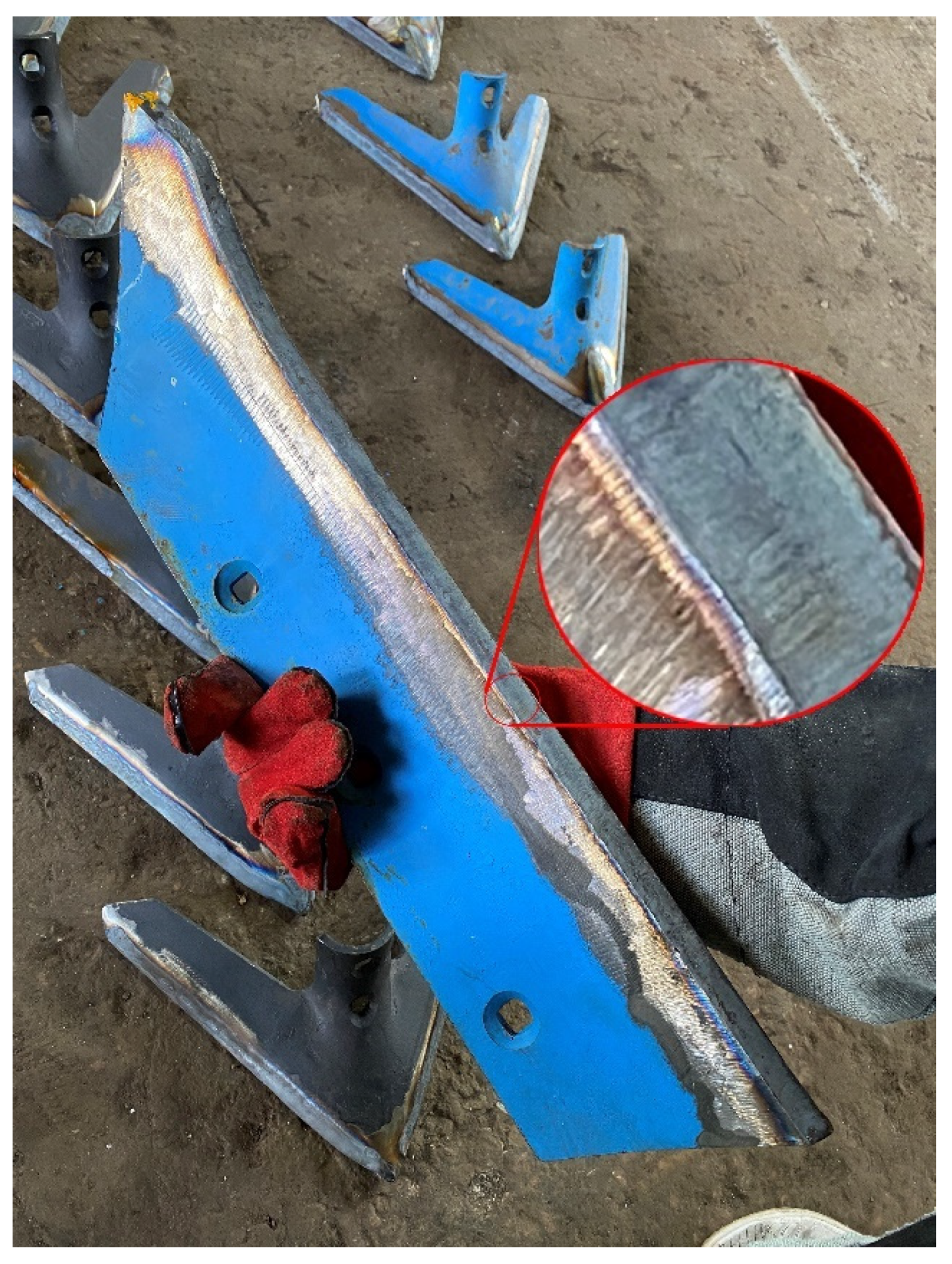The Method of Calculating Ploughshares Durability in Agricultural Machines Verified on Plasma-Hardened Parts
Abstract
1. Introduction
2. Material and Methods
2.1. Calculation Methodology Model
- -
- Types of soils: sandy, light-loamy, and light-clayey;
- -
- Soil hardness: , , ;
- -
- Ploughing speed: = 10 km/h;
- -
- Performance of the plough body: A = 0.35 ha/h;
- -
- The angle of inclination of the ploughshare to the bottom of the furrow, β = 30°.
- -
- Relative wear resistance, ε = 1.28 for 65G steel and at the reference pressure of the abrasive medium;
- -
- Original tip blade thickness, b = 2 mm;
- -
- Limiting wear rate of the tip in height, ;
- -
- Limiting blade thickness at , a = 3 mm; at = 3 MPa, a = 5 mm; at = 1 MPa, a = 7 mm.
2.2. Methods of Confirming the Results of Calculations by Experiment
3. Results
4. Discussion
Author Contributions
Funding
Institutional Review Board Statement
Informed Consent Statement
Data Availability Statement
Acknowledgments
Conflicts of Interest
References
- Seok, J.H.; Moon, H. Agricultural Exports and Agricultural Economic Growth in Developed Countries: Evidence from OECD Countries. J. Int. Trade Econ. Dev. 2021, 30, 1004–1019. [Google Scholar] [CrossRef]
- Kipriyanov, F.A.; Medvedeva, N.A.; Medvedeva, S.V. Ensuring the Operational Reliability of the Tractor Fleet. IOP Conf. Ser. Earth Environ. Sci. 2019, 315, 062015. [Google Scholar] [CrossRef]
- Miodragović, R.; Tanasijević, M.; Mileusnić, Z.; Jovančić, P. Effectiveness Assessment of Agricultural Machinery Based on Fuzzy Sets Theory. Expert Syst. Appl. 2012, 39, 8940–8946. [Google Scholar] [CrossRef]
- Shilovsky, V.N.; Pitukhini, E.A.; Skobtsov, I.G. Technique for Improving the Organization of Maintenance of Transport and Technological Vehicles. IOP Conf. Ser. Earth Environ. Sci. 2021, 666, 062089. [Google Scholar] [CrossRef]
- Beaton, A.J.; Dhuyvetter, K.C.; Kastens, T.L.; Williams, J.R. Per unit costs to own and operate farm machinery. J. Agric. Appl. Econ. 2005, 37, 131–144. [Google Scholar] [CrossRef][Green Version]
- Galiev, I.; Khafizov, C.; Adigamov, N.; Khusainov, R. Increase of Efficiency of Tractors Use in Agricultural Production. Eng. Rural Dev. 2018, 17, 23–25. [Google Scholar] [CrossRef]
- Gulyarenko, A.A. Calculation Method of the Reasonable Reliability Level Based on the Cost Criteria. J. Mach. Manuf. Reliab. 2018, 47, 96–103. [Google Scholar] [CrossRef]
- Babchenko, L.A.; Gulyarenko, A.A. Data Control for Reliability of Agricultural Tractors. J. Mach. Manuf. Reliab. 2020, 49, 900–906. [Google Scholar] [CrossRef]
- Starovoytov, S.I.; Akhalaya, B.K.; Sidorov, S.; Mironova, A. The trend of tillage equipment development. AMA Agric. Mech. Asia Afr. Lat. Am. 2020, 51, 77–81. Available online: https://www.agriculturalmechanization.com/app/download/14479928935/VOL.51_NO.3_SUMMER_2020.pdf?t=1611645201 (accessed on 10 May 2022).
- Ranjbarian, S.; Askari, M.; Jannatkhah, J. Performance of Tractor and Tillage Implements in Clay Soil. J. Saudi Soc. Agric. Sci. 2017, 16, 154–162. [Google Scholar] [CrossRef]
- Mohamed, K.G.; Rezakalla, A.I. Reliability-based design optimization strategy for soil tillage equipment considering soil parameter uncertainty. Adv. Eng. Res. 2016, 16, 136–147. [Google Scholar] [CrossRef]
- Vladutoiu, L.; Vladut, V.; Voiculescu, I.; Matache, M.; Radu, O.; Biris, S.; Voicea, I.; Paraschiv, G.; Atanasov, A.; Usenko, M. Increasing Agricultural Machinery Active Parts Durability by Hardening. Aktualni Zadaci Meh. Poljopr. Actual Tasks Agric. Eng. 2015, 43, 153–164. Available online: https://www.researchgate.net/profile/Valentin-Vladut/publication/274286917_INCREASING_AGRICULTURAL_MACHINERY_ACTIVE_PARTS_DURABILITY_BY_HARDENING/links/57dfaaa808ae72d72eac3f3d/INCREASING-AGRICULTURAL-MACHINERY-ACTIVE-PARTS-DURABILITY-BY-HARDENING.pdf (accessed on 10 May 2022).
- Owsiak, Z. Wear of Spring Tine Cultivator Points in Sandy Loam and Light Clay Soils in Southern Poland. Soil Tillage Res. 1999, 50, 333–340. [Google Scholar] [CrossRef]
- Motorin, V.A.; Gapich, D.S.; Borisenko, I.B.; Kurbanov, D.B. Simulation of the Wear of the Working Bodies of Chisel Plows. J. Frict. Wear 2020, 41, 71–77. [Google Scholar] [CrossRef]
- Kostencki, P.; Stawicki, T.; Białobrzeska, B. Durability and Wear Geometry of Subsoiler Shanks Provided with Sintered Carbide Plates. Tribol. Int. 2016, 104, 19–35. [Google Scholar] [CrossRef]
- Dickey, E.C.; Shelton, D.P.; Meyer, G.; Fairbanks, K. Determining crop residue cover with electronic image analysis. In Proceedings of the Eleventh International Congress on Agricultural Engineering, Dublin, Ireland, 4–8 September 1989; pp. 3056–3064. [Google Scholar]
- Bialobrzeska, B.; Kostencki, P. Abrasive Wear Characteristics of Selected Low-Alloy Boron Steels as Measured in Both Field Experiments and Laboratory Tests. Wear 2015, 328–329, 149–159. [Google Scholar] [CrossRef]
- Mironov, D.A.; Sidorov, S.A.; Liskin, I.V. Strength and Durability Characteristics of Soil-Cutting Working Tools. Agric. Mach. Technol. 2019, 13, 39–43. [Google Scholar] [CrossRef]
- Erokhin, M.N.; Novikov, V.S. Forecasting Durability of Working Elements Of Designed Soil-Cultivating Machines. Vestn. Fed. State Educ. Inst. High. Prof. Educ. Mosc. State Agroengineering Univ. Named After V.P. Goryachkin 2017, 6, 56–62. [Google Scholar] [CrossRef]
- Jankauskas, V.; Katinas, E.; Pusvaškis, M.; Leišys, R. A Study of the Durability of Hardened Plough Point. J. Frict. Wear 2020, 41, 78–84. [Google Scholar] [CrossRef]
- Katsitadze, J.; Kapanadze, I.; Kutelia, G.; Bidzinashvili, I. Research on Reliability of Plows Operating in Mountainous Conditions. Mach. Technol. Mater. 2016, 10, 7–9. Available online: https://stumejournals.com/journals/mtm/2016/3/7.full.pdf (accessed on 10 May 2022).
- Tajbakhsh, O.; Karparvarfard, S.H. Estimation of the fuel consumption rate of tractor due to different aspect ratios of chisel plow blade. Iran. J. Biosyst. Eng. 2015, 46, 201–208. [Google Scholar] [CrossRef]
- ALkhafaji, A.J.; Almosawi, A.A.; Alqazzaz, K.M. Performance of Combined Tillage Equipment and It’s Effect on Soil Properties. Int. J. Environ. Agric. Biotechnol. 2018, 3, 799–805. [Google Scholar] [CrossRef]
- Aulin, V.; Warouma, A.; Lysenko, S.; Kuzyk, A. Improving of the Wear Resistance of Working Parts Agricultural Machinery by the Implementation of the Effect of Self-Sharpening. Int. J. Eng. Technol. 2016, 5, 126. [Google Scholar] [CrossRef][Green Version]
- Selig, E.T.; Nelson, R.D. Observations of Soil Cutting with Blades. J. Terramechanics 1964, 1, 32–53. [Google Scholar] [CrossRef]
- Siemens, J.; Weber, J.; Thornburn, T. Mechanics of soil as influenced by model tillage tools. Trans. ASAE 1965, 8, 1–0007. [Google Scholar] [CrossRef]
- Natsis, A.; Petropoulos, G.; Pandazaras, C. Influence of Local Soil Conditions on Mouldboard Ploughshare Abrasive Wear. Tribol. Int. 2008, 41, 151–157. [Google Scholar] [CrossRef]
- Nalbant, M.; Palali, A.T. Effects of different material coatings on the wearing of plowshares in soil tillage. Turk. J. Agric. For. 2011, 35, 215–223. [Google Scholar] [CrossRef]
- Er, U.; Par, B. Wear of Plowshare Components in SAE 950C Steel Surface Hardened by Powder Boriding. Wear 2006, 261, 251–255. [Google Scholar] [CrossRef]
- Rempp, A.; Widmann, M.; Killinger, A.; Gadow, R. Advanced Ceramic/Metal Polymer Multilayered Coatings for Industrial Applications. Key Eng. Mater. 2012, 533, 133–144. [Google Scholar] [CrossRef]
- Oliveira, T.G.d.; Costa, A.R.d. Influence of microstructure on micro-abrasive wear resistance of alloys Fe-Cr-C and Fe-Cr-C-Nb. Matéria 2019, 24, 1. [Google Scholar] [CrossRef]
- Wang, J.; Lu, J.; Xing, X.; Zhou, Y.; Liu, S.; Qi, X.; Yang, Q. Effects of B Contents on the Microstructure and Wear Resistance of Hypereutectic Fe-Cr-C Hardfacing Alloy Coating. Mater. Res. Express 2019, 6, 1065h2. [Google Scholar] [CrossRef]
- Latypov, R.; Serov, A.; Serov, N.; Chekha, O. Technology of Hardening Plowshares by Electrocontact Welding Using Waste from Tool Production. In Robotics, Machinery and Engineering Technology for Precision Agriculture; Springer: Singapore, 2021; pp. 197–203. [Google Scholar] [CrossRef]
- Titov, N.V.; Kolomeichenko, A.V.; Logachev, V.N.; Kravchenko, I.N.; Litovchenko, N.N. Investigation of the Hardness and Wear Resistance of Working Sections of Machines Hardened by Vibroarc Surfacing Using Cermet Materials. Weld. Int. 2015, 29, 737–739. [Google Scholar] [CrossRef]
- Remshev, E.Y.; Danilin, G.A.; Vorob’eva, G.A.; Silaev, M.Y. Ensuring the Operational Reliability of Elastic Elements by Acoustic Methods. Metallurgist 2015, 59, 225–228. [Google Scholar] [CrossRef]
- Kornilovich, S.A.; Redreev, G.V.; Vorobyov, D.A.; Zakharov, S.V. Improvement of Adhesion Strength of the Sprayed Material. IOP Conf. Ser. Mater. Sci. Eng. 2019, 582, 012042. [Google Scholar] [CrossRef]
- Królicka, A.; Szczepański, Ł.; Konat, Ł.; Stawicki, T.; Kostencki, P. The Influence of Microstructure on Abrasive Wear Micro-Mechanisms of the Claddings Produced by Welding Used in Agricultural Soil. Materials 2020, 13, 1920. [Google Scholar] [CrossRef]
- Borawski, A.; Szpica, D.; Mieczkowski, G.; Awad, M.M.; Shalaby, R.M.; Sallah, M. Proposition of Abrasion Resistance Determining Method of Materials Used for Production of Plowshares. In Proceedings of the International Scientific Conference Engineering for Rural Development, Jelgava, Latvia, 26–28 May 2021. [Google Scholar] [CrossRef]
- Swanson, P.; Vetter, A. The measurement of abrasive particle shape and its effect on wear. ASLE Trans. 1985, 28, 225–230. [Google Scholar] [CrossRef]
- Taha, S.; Taha, F.; Nekolayevech, Z. Estimating economical costs for operating agricultural machines and equipment during plowing operations. Iraqi J. Agric. Sci. 2016, 47, 385–390. [Google Scholar] [CrossRef]
- Kanaev, A.; Nukeshev, S.; Zhusin, B.; Milokumov, V. The Experience and the Problems in Improvement of Technical Level and Economic Effectiveness of Agricultural Machinery. Sci. Rev. 2012, 2, 21–27. Available online: https://kazatu.edu.kz/assets/i/science/sr2012_I10_05.pdf (accessed on 10 May 2022).
- Molenhuis, J. Budgeting Farm Machinery Costs; Ontario Ministry of Agriculture, Food and Rural Affairs: Guelph, ON, Canada, 2001; Available online: https://files.ontario.ca/omafra-budgeting-farm-machinery-costs-20-007-en-2020-05-12.pdf (accessed on 10 May 2022).
- Krivtsov, A. Forecasting the nature of the formation of two-layer soil-cutting profiles in the process of wear. Agro Panorama 2005, 2, 24–28. Available online: https://rep.bsatu.by/bitstream/doc/11383/1/krivcov-a-v-prognozirovanie-haraktera-formoobrazovaniya-dvuhslojnyh-pochvorezhushchih-profilej-v-processe-iznashivaniya.pdf (accessed on 10 May 2022).
- Sidorov, S.A.; Mironov, D.A.; Tsench, Y.S.; Mironova, A.V. Evaluation of wear resistance and resource of two-layer hardened soil-cutting working bodies in various soil conditions. Eng. Technol. Syst. 2020, 30, 699–710. [Google Scholar] [CrossRef]
- Orekhova, G. Forecasting the durability of plow shares in the treatment of soils of different degrees of moisture. Bull. Bryansk State Agric. Acad. 2020, 2, 28–32. Available online: https://cyberleninka.ru/article/n/prognozirovanie-dolgovechnosti-pluzhnyh-lemehov-pri-obrabotke-pochv-raznoy-stepeni-vlazhnosti (accessed on 10 May 2022).
- Korshunov, V.Y. Calculation of the wear rate of deposited materials during the restoration of tillage implements. Rural Mach. Oper. 2020, 1, 32–33. Available online: https://libryansk.ru/files/projectimage/agro/text/korshunov_sm_2020_01.pdf (accessed on 10 May 2022).
- Gray, R.D. Alloys and AutomobilesThe Life of Elwood Haynes; Indiana Historical Society: Indianapolis, IN, USA, 1979. [Google Scholar]
- Sidorov, S.; Mironov, D.; Khoroshenkov, V.; Khlusova, E. Surfacing methods for increasing the service life of rapidly wearing working tools of agricultural machines. Weld. Int. 2016, 30, 808–812. [Google Scholar] [CrossRef]
- Kostencki, P.; Stawicki, T.; Królicka, A.; Sędłak, P. Wear of cultivator coulters reinforced with cemented-carbide plates and hardfacing. Wear 2019, 438, 203063. [Google Scholar] [CrossRef]
- Lvov, P. A Method of Surfacing Wear-Resistant Alloys. 1951. Available online: https://rusneb.ru/catalog/000224_000128_0000092002_19510101_A1_SU/ (accessed on 10 May 2022).
- Erokhin, M.; Novikov, V. Increasing the strength and wear resistance of the plowshare. Agroengineering 2008, 3, 100–107. Available online: https://cyberleninka.ru/article/n/povyshenie-prochnosti-i-iznosostoykosti-lemeha-pluga (accessed on 10 May 2022).
- Katsitadze, J.; Pawlowski, T.; Phutkaradze, Z. Plowshares Wear Investigation of the Plows Working in Mountainous Conditions Using Statistical Probabilistic Modeling. J. Agric. Sci. Technol. A 2018, 8, 253–257. [Google Scholar] [CrossRef]
- Dzhabborov, N.I.; Dobrinov, A.V.; Jabborov, P.N. Research and Modeling of the Wear Process of Parts of the Soil Tillage Working Implements. IOP Conf. Ser. Earth Environ. Sci. 2021, 699, 012038. [Google Scholar] [CrossRef]
- Ozhegov, N.; Dzhabborov, N.; Dobrinov, A.; Fedkin, D. Estimation of wear rate of hard faced ploughshares. In Proceedings of the Environmentally Friendly Agriculture and Forestry for Future Generations, Saint Petersburg, Russia, 26–28 February 2015; pp. 191–193. Available online: https://elibrary.ru/item.asp?id=24861069 (accessed on 10 May 2022).
- Buylov, V.N.; Lyulyakov, I.V.; Makarov, S.A.; Danilin, A.V.; Chekmarev, V.V. Forecasting of the Soil Processing Units Working Bodies Resource. IOP Conf. Ser. Earth Environ. Sci. 2020, 422, 012115. [Google Scholar] [CrossRef]
- Bartenev, I.; Pozdnyakov, E. Wearing ability of soils and its effect on the durability of the working bodies of tillage machines. J. For. Eng. 2013, 3, 114–123. [Google Scholar] [CrossRef]
- Myalenko, V.I. Modeling of Reliability When Designing Soil Cutting Parts of Agricultural Machines. Tract. Agric. Mach. 2015, 82, 44–47. [Google Scholar] [CrossRef]
- Korotkov, V.A. Strengthening of Steel by Plasma Quenching and Carbonitriding. Russ. Eng. Res. 2019, 39, 234–236. [Google Scholar] [CrossRef]
- Kanaev, A.; Gulyarenko, A.; Bogomolov, A.; Sarsembaeva, T. Analysis of mechanisms for hardening constructional steels by structure parameters. Metalurgija 2022, 61, 241–243. Available online: https://hrcak.srce.hr/clanak/381655 (accessed on 10 May 2022).
- Kanaev, A.T.; Gulyarenko, A.A.; Sarsembaeva, T.E.; Ayazbaeva, A.B. Structure Formation under Plasma-Assisted Hardening of Thin-Walled Low-Weight Parts. Steel Transl. 2021, 51, 582–586. [Google Scholar] [CrossRef]
- Yang, L.J. Plasma Surface Hardening of ASSAB 760 Steel Specimens with Taguchi Optimisation of the Processing Parameters. J. Mater. Processing Technol. 2001, 113, 521–526. [Google Scholar] [CrossRef]
- Korotkov, V.A. Impact of Plasma Hardening on the Wear Resistance of 38XC Steel. J. Frict. Wear 2017, 38, 302–304. [Google Scholar] [CrossRef]
- Korotkov, V.A. Properties and Commercial Application of Manual Plasma Hardening. Met. Sci. Heat Treat. 2016, 58, 449–454. [Google Scholar] [CrossRef]
- Konstantinova, M.; Balanovskiy, A.; Gozbenko, V.; Kargapoltsev, S.; Karlina, A.; Shtayger, M.; Guseva, E.; Kuznetsov, B. Application of plasma surface quenching to reduce rail side wear. In IOP Conference Series: Materials Science and Engineering; IOP Publishing: Bristol, UK, 2019; p. 012146. [Google Scholar] [CrossRef]
- Yang, Y.; Yan, M.; Zhang, S.; Guo, J.; Jiang, S.; Li, D. Diffusion behavior of carbon and its hardening effect on plasma carburized M50NiL steel: Influences of treatment temperature and duration. Surf. Coat. Technol. 2018, 333, 96–103. [Google Scholar] [CrossRef]
- Wu, B.; Li, J.; Ye, J.; Tan, J.; Liu, L.; Song, J.; Chen, X.; Pan, F. Work hardening behavior of Ti particle reinforced AZ91 composite prepared by spark plasma sintering. Vacuum 2021, 183, 109833. [Google Scholar] [CrossRef]
- Krawczyk, J.; Bembenek, M.; Pawlik, J. The Role of Chemical Composition of High-Manganese Cast Steels on Wear of Excavating Chain in Railway Shoulder Bed Ballast Cleaning Machine. Materials 2021, 14, 7794. [Google Scholar] [CrossRef]
- Bembenek, M.; Krawczyk, J.; Pańcikiewicz, K. The Wear on Roller Press Rollers Made of 20Cr4/1.7027 Steel under Conditions of Copper Concentrate Briquetting. Materials 2020, 13, 5782. [Google Scholar] [CrossRef]
- Krawczyk, J.; Bembenek, M.; Frocisz, Ł.; Śleboda, T.; Paćko, M. The Effect of Sandblasting on Properties and Structures of the DC03/1.0347, DC04/1.0338, DC05/1.0312, and DD14/1.0389 Steels for Deep Drawing. Materials 2021, 14, 3540. [Google Scholar] [CrossRef]
- Orynbekov, D.; Sarsembayeva, T.; Kanaev, A.; Gulyarenko, A. Nanoparticle-strengthened-martensitic Surface Layered Constructed Steel by Plasma Hardening Rout. J. Nanostruct. 2021, 11, 814–824. [Google Scholar] [CrossRef]
- Saburkin, D.A. Increasing the Durability of the Plowshare by Improving Its Design and Technological Parameters; Moscow State Agroengineering University: Moscow, Russia, 2008; Available online: https://static.freereferats.ru/_avtoreferats/01003440483.pdf (accessed on 10 May 2022).





| Soil Type | Relative Wear Capacity of the Soil, m |
|---|---|
| Sandy soil | 0.87 |
| Sandy-loam soil | 0.62 |
| Loamy soil: | |
| light | 0.42 |
| medium | 0.32 |
| heavy | 0.22 |
| Clayey soil: | |
| light | 0.15 |
| medium | 0.10 |
| heavy | 0.06 |
| Quartz particles with a size of 0.16 ÷ 0.32 μm | 1.0 |
| Parameter | Parameter Values on Soil | ||||||||
|---|---|---|---|---|---|---|---|---|---|
| Sandy | Loamy (Light) | Clayey (Light) | |||||||
| Hardness, MPa | |||||||||
| 1 | 3 | 5 | 1 | 3 | 5 | 1 | 3 | 5 | |
| Soil pressure on the tip, , MPa | 0.48 | 0.82 | 1.24 | 0.48 | 0.82 | 1.24 | 0.48 | 0.82 | 1.24 |
| Soil pressure on the blade, , MPa | 0.12 | 0.27 | 0.31 | 0.12 | 0.27 | 0.31 | 0.12 | 0.27 | 0.31 |
| Serial ploughshare service life, ha: | |||||||||
| tip | 9.8 | 4.85 | 2.95 | 20.7 | 10.0 | 6.03 | 58.8 | 28.3 | 16.7 |
| blade | 28.5 | 4.6 | 2.06 | 60.4 | 10.1 | 4.42 | 166.2 | 28.4 | 12.5 |
| The ratio of the service lives of the blade and the tip | 2.9 | 0.95 | 0.69 | 2.9 | 1.01 | 0.73 | 2.82 | 1.01 | 0.74 |
| The service life of the test ploughshare of 65G steel, ha: | |||||||||
| tip | 14.02 | 6.94 | 4.15 | 29.7 | 14.6 | 8.66 | 81.4 | 40.4 | 23.9 |
| blade | 79.3 | 12.35 | 3.31 | 160.0 | 26.2 | 6.9 | 450.0 | 72.1 | 19.3 |
| The ratio of the service lives of the blade and the tip | 5.65 | 1.78 | 0.79 | 5.38 | 1.79 | 0.8 | 5.52 | 1.78 | 0.8 |
| Hardened Material, Its Relative Wear Resistance | The Thickness of the Hardened Layer, mm | The Relative Wear Resistance of the Tip | The Potential Life of the Tip, Ha |
|---|---|---|---|
| 1.6 | 1.28 | 31.6 |
| Hardness on HRC Scale before Hardening, Steel 65G (Serial Sample) | Hardness on HRC Scale after Hardening, Steel 65G | |
|---|---|---|
| The average of middle 10 measurnet (without 5 max. and 5 min.) | 18.2 | 53.2 |
| Standard deviation | 0.70 | 2.64 |
| Variance | 0.49 | 6.97 |
Publisher’s Note: MDPI stays neutral with regard to jurisdictional claims in published maps and institutional affiliations. |
© 2022 by the authors. Licensee MDPI, Basel, Switzerland. This article is an open access article distributed under the terms and conditions of the Creative Commons Attribution (CC BY) license (https://creativecommons.org/licenses/by/4.0/).
Share and Cite
Gulyarenko, A.; Bembenek, M. The Method of Calculating Ploughshares Durability in Agricultural Machines Verified on Plasma-Hardened Parts. Agriculture 2022, 12, 841. https://doi.org/10.3390/agriculture12060841
Gulyarenko A, Bembenek M. The Method of Calculating Ploughshares Durability in Agricultural Machines Verified on Plasma-Hardened Parts. Agriculture. 2022; 12(6):841. https://doi.org/10.3390/agriculture12060841
Chicago/Turabian StyleGulyarenko, Alexandr, and Michał Bembenek. 2022. "The Method of Calculating Ploughshares Durability in Agricultural Machines Verified on Plasma-Hardened Parts" Agriculture 12, no. 6: 841. https://doi.org/10.3390/agriculture12060841
APA StyleGulyarenko, A., & Bembenek, M. (2022). The Method of Calculating Ploughshares Durability in Agricultural Machines Verified on Plasma-Hardened Parts. Agriculture, 12(6), 841. https://doi.org/10.3390/agriculture12060841







